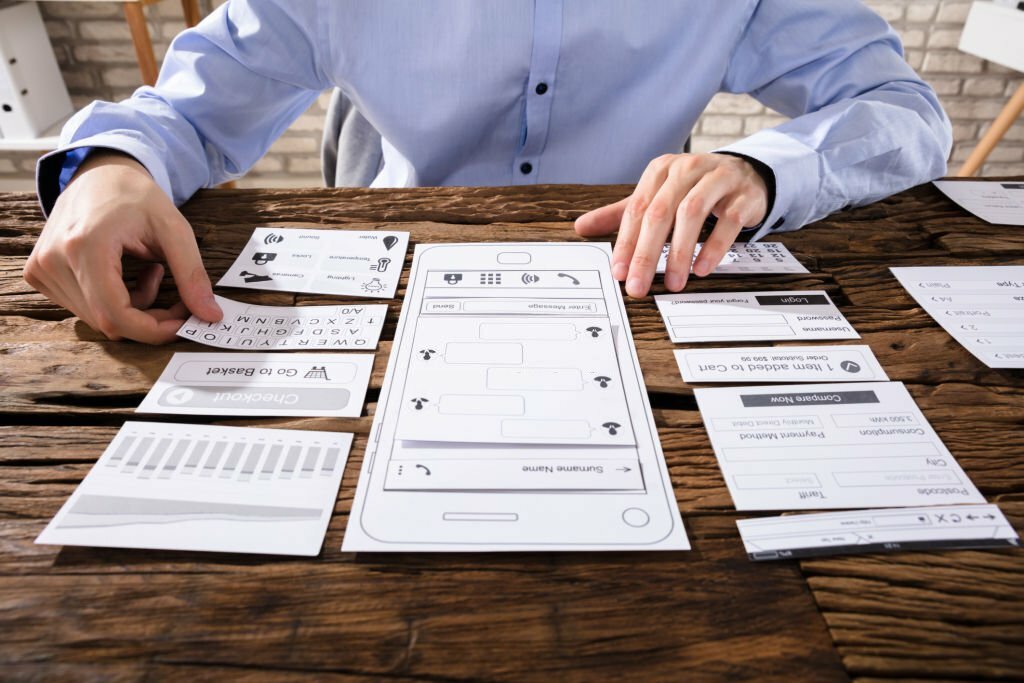What is Design Thinking DTMethod

Design Thinking is a user-centric and iterative approach to problem solving. It has revolutionised how we tackle challenges and fostered groundbreaking, innovative solutions over decades.
At its core, the Design Thinking process is a deeply empathetic approach that places the user at the forefront of the problem-solving process. It emphasises the importance of understanding user needs, aspirations, and pain points. Design Thinking ensures solutions are technologically feasible or economically viable and desirable and effective for the intended users.
Unlike traditional problem-solving methods that often follow a linear path, Design Thinking is an iterative and adaptive approach. This means that a few ideas are not just generated and tested once; they are continuously refined and improved based on user feedback and insights gathered throughout the process.
What is Design Thinking DTMethod?
The seeds of Design Thinking were sown in the 1950s by John E. Arnold, a Stanford University professor who advocated for a user-centred approach to design. Arnold’s work laid the foundation for the concept of human-centred design, emphasising the importance of understanding user needs and preferences in developing products and services.
In the 1980s, human-centred design gained momentum, driven by a growing recognition of its effectiveness in creating innovative ideas that meet user needs and achieve business goals. This movement was further fueled by the establishment of IDEO in 1991, a renowned design consultancy that pioneered the application of Design Thinking, demonstrating its versatility in addressing challenges across various industries.
When the early 21st century came, the Design Thinking process became formalised as a methodology. Stanford University’s d.school, founded in 2005, played a pivotal role in this development, pioneering Design Thinking education and establishing it as a valuable tool for innovation across various disciplines. The d.school’s approach to Design Thinking emphasised empathy, collaboration, and a hands-on, iterative process, setting the stage for widespread adoption across industries and organisations.
The Principles of Design Thinking
Design Thinking prioritises empathy and hands-on solutions to create innovative solutions that meet user needs and achieve business goals. The process balances between technical feasibility, economic viability, but with emphasis on user desirability.
User-centricity: At the heart of Design Thinking lies empathy, the ability to understand and share the feelings of others. This user centric approach, aspirations, and challenges drives the entire Design Thinking process, ensuring that solutions are always effective for the intended users.
Hands-on Approach: Design Thinking is an active and hands-on process that encourages experimentation, prototyping, and testing. This hands-on approach allows for rapid iteration and refinement of ideas, ensuring that solutions are constantly evolving and adapting to user feedback.
Balancing Feasibility, Viability, and Desirability: Design Thinking recognises that successful solutions must meet the criteria of technical feasibility, economic viability, and user desirability. Technical feasibility ensures that the solution can be implemented with the available technology and resources. Economic viability ensures the solution can be developed and sustained within a business context. User desirability ensures that the solution meets the needs and preferences of the target users.
The Five Stages of the Design Thinking Process
The Design Thinking process is typically divided into five stages: Empathise, Define, Ideate, Prototype, and Test. This iterative process allows for flexibility while also being efficient.
1. Empathise with The Users
The first stage of Design Thinking, Empathise, focuses on understanding the needs, wants, and challenges of the users. This stage involves immersing oneself in the user’s world, gaining insights into their behaviours, motivations, and pain points. Common methods used in the Empathise stage include:
- Surveys: Surveys can provide a broad overview of user needs and preferences, allowing for the collection of quantitative data. This can be helpful in identifying trends and patterns across a large user base.
- Interviews: One-on-one interviews allow for deeper conversations with users, gaining qualitative insights into their experiences and perspectives. This can reveal deeper motivations, challenges, and unspoken needs that may not be captured in surveys.
- Observation Sessions: Observing users in their natural environment can reveal unspoken needs, behaviours, and interactions that may not be explicitly expressed in interviews or surveys. This can provide valuable insights into how users interact with products, services, and their surroundings.
By understanding the users’ perspectives, we can identify unmet needs and opportunities for innovation.
2. Define the Problem
The Define stage involves synthesising the findings from the Empathise stage into a clear, human-centred problem statement. This problem statement articulates the core challenge that needs to be addressed, providing focus and direction for the subsequent stages.
To define the problem effectively, it is important to:
- Identify the root cause of the problem: Dig deeper than surface-level symptoms to uncover the underlying causes of user pain points and challenges. This ensures that the alternative solutions address the true root of the problem.
- Frame the problem from a user perspective: Use user language and terminology to ensure the problem statement resonates with the target users. This helps to ensure that the solutions are designed to address the needs of the people who will be using them.
- Keep the problem statement concise and actionable: Avoid ambiguity and ensure the problem statement is clearly defined and actionable. This provides a clear focus for the ideation and prototyping stages.
Simplifying the findings into a very short problem statement is a crucial step that’s often overlooked. If the problem statement is clear and concise, the solutions are often easier to find and the criteria for success is much easier to see.
3. Ideate Solutions
The Ideate stage is the third phase, dedicated to generating a wide range of solutions to the defined problem. This stage encourages creative solutions and exploration of unconventional approaches, breaking free from existing limitations and preconceived notions.
Techniques for Ideation:
- Brainstorming: Brainstorming is a classic ideation phase that involves generating as many ideas as possible in a short period of time. The key is to encourage participants to think freely and avoid criticism or filtering.
- Sketching: Sketching is a quick and effective way to visualise ideas. It allows designers to capture their thoughts and communicate them to others without having to spend a lot of time on refining them.
- Mind Mapping: Mind mapping visually represents ideas and their connections. It can help to organise thoughts, identify patterns, and uncover new connections between ideas.
- Bodystorming: Bodystorming is a more physical form of brainstorming that involves acting out potential solutions. This can help to gain a deeper understanding of how users might interact with a product or service.
- Reverse Thinking: Reverse thinking involves reframing the problem from an opposite perspective. It helps to break free from existing assumptions and explore new possibilities.
Also, reframing the problem from an opposite perspective can further stimulate innovative thinking.
4. The Prototype Stage
The Prototype stage involves creating scaled-down versions of potential solutions. Prototypes can range from low-fidelity sketches and paper models to more refined digital mockups or physical prototypes. The goal is to create a tangible representation of the idea to gather feedback and test its functionality.
Prototypes are scaled-down versions of potential solutions that allow designers to test their ideas with real users, improve problem solving, and gather feedback.
Types of Prototypes:
- Low-fidelity prototypes: Low-fidelity prototypes are made from inexpensive materials like paper or cardboard. They are quick and easy to create, and they are useful for testing basic concepts and functionality. For the software side, the low-fidelity equivalent needs to be better designed but working prototypes.
- High-fidelity prototypes: High-fidelity prototypes are more refined and realistic representations of the final product or service. They can be used to test user experience, gather feedback on specific features, and make final design decisions. These need more resources and time to create but are often necessary for testing naturally robust ideas.
There are several reasons why you should always go through the prototyping stage:
- Allows for rapid iteration: Prototyping will enable designers to quickly test and refine their ideas without investing much time and resources. This design thinking process helps to ensure that the final solution is well-tested and refined before it is implemented.
- Provides valuable user feedback: Prototyping allows designers to gather feedback from real users, which can help to identify and address potential issues early on. This feedback is essential for creating a product or service that genuinely meets user needs.
- Reduces the risk of failure: By testing prototypes early and often, designers can reduce the risk of failure. This can save time and money in the long run, and it can help to ensure that the final product or service is successful.
Prototyping allows designers to quickly identify flaws, gather user feedback, and improve the solution before investing in more time and resources. This iterative process ensures that the final solution is well-tested and refined before implementation.
5. Testing Phase
The final stage is the Test stage, where prototypes are evaluated with real users to gather feedback and refine the solution. This feedback is used to identify areas for improvement, ensuring that the final solution meets user needs effectively.
Testing Methods:
- User interviews: User interviews allow designers to ask users questions about their experiences with the prototype. This can provide valuable insights into how users interact with the product and identify any pain points or areas for improvement.
- Usability testing: Usability testing involves observing users as they interact with the prototype. This can help identify usability issues and ensure the product is easy to use.
- A/B testing: A/B testing involves comparing two versions of a prototype to see which one performs better. This can be used to test different design elements or features.
Testing ensures the final solution meets user needs and expectations. Doing this identifies and addresses usability issues early on, saving time and money in the long run.
Designers can ensure their solutions are user-centred and effective by testing early and often.

Design Thinking in Action: Airbnb
Airbnb used the Design Thinking process to revolutionise its business and address complex challenges in 2009. The company was able to transform from a struggling startup to a billion-dollar business over several years using Design Thinking to solve complex problems and drive innovation:
- Enhanced Photo Quality: In 2009, Airbnb faced stagnation with a weekly revenue of only $200. During a session with Paul Graham, the design team noticed a pattern in their New York City listings – the photos were subpar. This realisation led to a shift in focus towards improving the quality of the photos, demonstrating a keen understanding of user experience and the impact of visual content on customer engagement. They implemented a program to send professional photographers to take photos of listings, significantly improving the visual appeal of the platform.
- Improving Host-Guest Interaction: Airbnb conducted in-depth foundational research to understand why hosts reject guests, leading to the “Why Hosts Reject” initiative. By focusing on delivering the best user experience, Airbnb formed a design team to conduct research and used existing host and guest personas to approach problem areas, demonstrating a commitment to user-centric design thinking.
- Instant Book Feature: Airbnb introduced the Instant Book feature, allowing guests to book properties without prior host approval. It streamlined the booking process and increased booking rates.
- Personalised Recommendations: Airbnb utilises user data and algorithms to provide personalised recommendations for properties tailored to individual preferences and travel patterns. This enhances the user experience and increases the likelihood of successful bookings.
- Trust and Safety Measures: Airbnb has implemented various measures to ensure its guests’ and hosts’ safety and security. This includes a comprehensive verification process for both parties, a robust guest review system, and 24/7 customer support.
- Mobile App Optimization: Airbnb has continuously refined its mobile app, making it intuitive, user-friendly, and optimised for various devices. This ensures a seamless booking and travel experience for guests on the go.
In summary, Airbnb’s successful application of Design Thinking involved identifying user-centric patterns, embracing a creative solution-based approach, encouraging measured risk-taking, and empowering employees to drive innovation. These strategies enabled Airbnb to address “wicked” problems and transform its business, showcasing the effectiveness of Design Thinking in tackling complex and ill-defined challenges.
Why Design Thinking Matters
Genuinely groundbreaking and impactful innovation stems from a deep understanding of human needs, aspirations, and behaviours. This is where Design Thinking comes in. The Design Thinking methodology is also a mindset, a way of thinking that puts the user first. By placing the user at the heart of the innovation process, Design Thinking empowers businesses to create significant and relevant solutions.
Conclusion: Innovative Solutions and An Iterative Process
The Design Thinking methodology is one of the best methods for individuals and organisations to create meaningful solutions. Its human-centred approach generates as many ideas that address real-world needs. By placing the user at the heart of the process, Design Thinking ensures that solutions deeply resonate with the people they are intended to serve.
As we navigate an increasingly interconnected and rapidly changing world, Design Thinking offers a robust framework for remaining in touch with our customers and what truly matters.






